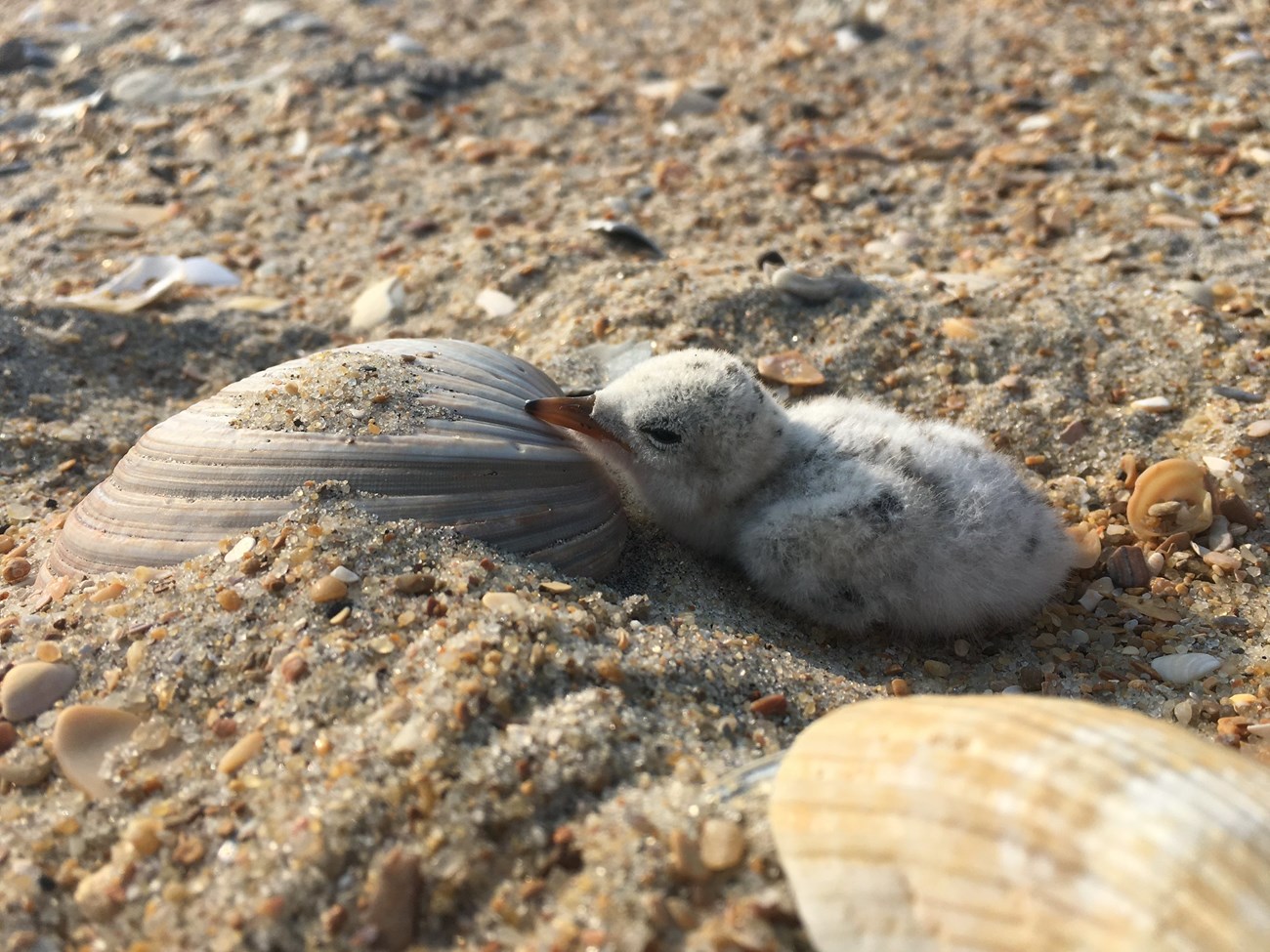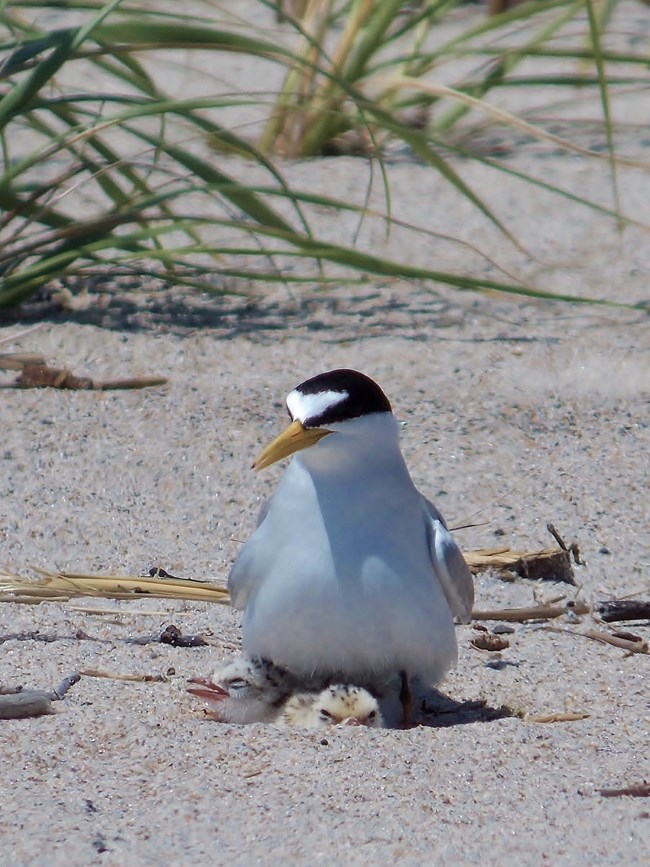
NPS Photo Description The least tern (Sternula antillarum) is 8 to 9 inches in length with a 19 to 21-inch wingspan. Breeding adults are pale gray and white, with a white forehead, black cap, a black line through its eye, a slender yellow bill, and orange legs. Non-breeding adults have a dark bill, smudgy grayish crowns, and may have a dark bar at the bend of the wing. The outer primary feathers on their long, narrow wings are dark gray-black. Juvenile coloration is similar to non-breeding adults, but they have a scaly gray appearance up higher on their bodies. Distribution and Abundance Along the Atlantic Coast Least terns breed in North, Middle, and South America and the Caribbean. In North America, the least tern breeds on the Atlantic coast from Maine to Florida and along the Gulf coast. On the Pacific coast, the least tern utilizes breeding grounds from California to Mexico. Least terns also can be found inland, mainly along major tributaries of the Missouri, Ohio, and Mississippi rivers. They will winter mainly off the eastern coasts of Central and South America. Least terns will arrive in Massachusetts to nest at coastal locations statewide in early-May. In 2019, 4,289 pairs were documented in Massachusetts. Cape Cod and the Islands host the largest populations of least terns in the state. In 2022, there were 16 least tern colonies at 12 Cape Cod National Seashore beaches. There were approximately 195 nesting pairs and 49 confirmed fledged chicks. This equates to 0.25 productivity (number of chicks fledged per pair). Once breeding has concluded, these seabirds will leave Massachusetts by early September (and in some years by early August) to travel to their wintering grounds. 
Photo/United States Fish and Wildlife Service Breeding and Feeding Habits Least terns are colonial nesters that utilize sandy, shelly beaches or islands on rivers and coastlines. In some cases, they will also use gravel pits, on dry mudflats, on flat gravel roofs, or on dredge spoil. These nesting locations are often barren with little to no vegetation. Both sexes make several nest scrapes with the female getting the final say on the site, which is often near the nest of other species such as Piping Plovers or Black Skimmers. The nest is a scrape in the sand or other substrate, occasionally including bits of vegetation, shells, or pebbles. The least terns will have 1 to 3 eggs that are incubated for 19 to 25 days. The hatchlings are born with their eyes open and covered in downy. This downy makes them highly camouflaged allowing them to blend in with their surroundings by laying down. They can walk, but they will typically stay in the nest for the first couple days. During the chick phase, they are unable to forage by themselves and will be fed by the adults. Fledging will occur after approximately three weeks and after another three weeks, young disperse from the natal site. Some groups of young and adults may congregate in groups called ‘nurseries’ to rest and forage prior to migration. It is important to protect nurseries so that terns can adequately rest and gain weight prior to migration. Family units migrate together. This seabird forages in lagoons, bays, estuaries, river and creek mouths, tidal marshes, and ponds. These shallow-water habitats provide the small fish, crustaceans, and insects they are after. In Massachusetts, least terns will primarily eat sand lance, hake, and herring. They hover over water and plunge to the water surface to capture their meals. Least terns can forage by themselves or in small flocks of 5 to 20 birds usually close to their nesting site, but they will venture further away if they need to find larger abundances of prey. Adults often carry small fish long distances to feed mates or young during nesting season. Least terns number have been reduced by 4.13% per year from 1966 to 2015. That results in a cumulative 87% decline over that time period. They are on a trajectory to lose another 50% of their remaining population in the next 50 years if conditions stay the same. The threats that face least terns and other shorebird species include increased predation (mostly by coyotes and crows), habitat loss, and human disturbance. Oil spills and other pollutants that impact water quality or affect the fish they eat are another threat. Climate change causing prey distribution and availability effects, sea-level rise, and increased storm frequency and intensity are changing the beach ecosystem that least terns rely on for nesting, staging, and foraging. Coastal development and sea-level rise have left humans and wildlife attempting to share a decreasing coastline. This causes fragmentation of least tern habitat, resulting in the colony being less successful in protection, leaving them more vulnerable to predators. Protections Least terns are considered a tipping point species according to the U.S. Committee of the North American Bird Conservation Initiative. This means they could be next to face threatened or endangered status. Proactive conservation could reverse the declines of least terns. Identifying causes and key actions, creating solutions with communities, developing a full annual cycle action plan, and taking coordinated action are the strategies that need to be employed to achieve sustainable recovery. Least terns are protected under the Migratory Bird Treaty Act of 1918, which prohibits the take (including killing, capturing, selling, trading, and transport) of protected migratory bird species without prior authorization by the Department of Interior U.S. Fish and Wildlife Service. They are also listed a Species of Concern by the U.S. Fish and Wildlife Service. Cape Cod National Seashore helps to protect critical breeding habitat and migration stop-over areas for many species of shorebirds. The protections allow these species a place to rest and a place to raise their next generations. Things You Can Do to Help Protect Least Terns and Other Shorebirds
|
Last updated: January 31, 2023
